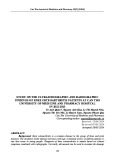
Radiographic findings
-
Knee osteoarthritis is a common disease in the group of bone and joint diseases. The incidence of the disease increases with age, commonly occurs in elderly patients or can also occur in young people. To describe and compare ultrasonographic and radiographic findings in osteoarthritis-affected knee joints.
 5p
5p  vinatisu
vinatisu
 29-08-2024
29-08-2024
 3
3
 0
0
 Download
Download
-
Chest radiographs and CT scans are needed to evaluate tumor size and nodal involvement; old radiographs are useful for comparison. CT scans of the thorax and upper abdomen are of use in the preoperative staging of NSCLC to detect mediastinal nodes and pleural extension and occult abdominal disease (e.g., liver, adrenal), and in planning curative radiation therapy. However, mediastinal nodal involvement should be documented histologically if the findings will influence therapeutic decisions.
 4p
4p  konheokonmummim
konheokonmummim
 03-12-2010
03-12-2010
 89
89
 7
7
 Download
Download
-
Approach to the Patient: Azotemia Once it has been established that GFR is reduced, the physician must decide if this represents acute or chronic renal injury. The clinical situation, history, and laboratory data often make this an easy distinction. However, the laboratory abnormalities characteristic of chronic renal failure, including anemia, hypocalcemia, and hyperphosphatemia, are often also present in patients presenting with acute renal failure. Radiographic evidence of renal osteodystrophy (Chap.
 5p
5p  ongxaemnumber1
ongxaemnumber1
 29-11-2010
29-11-2010
 72
72
 3
3
 Download
Download
-
Distinguishing Cardiogenic from Noncardiogenic Pulmonary Edema The history is essential for assessing the likelihood of underlying cardiac disease as well as for identification of one of the conditions associated with noncardiogenic pulmonary edema. The physical examination in cardiogenic pulmonary edema is notable for evidence of increased intracardiac pressures (S3 gallop, elevated jugular venous pulse, peripheral edema), and rales and/or wheezes on auscultation of the chest.
 5p
5p  ongxaemnumber1
ongxaemnumber1
 29-11-2010
29-11-2010
 59
59
 5
5
 Download
Download
CHỦ ĐỀ BẠN MUỐN TÌM
















